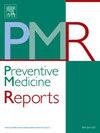糖尿病诊断对美国中年人预防保健利用的影响:抑郁症状的中介分析
IF 2.4
3区 医学
Q2 PUBLIC, ENVIRONMENTAL & OCCUPATIONAL HEALTH
引用次数: 0
摘要
目的探讨糖尿病诊断与预防保健利用的关系,以及抑郁症状是否在其中起中介作用。该研究使用了2006年至2016年在美国收集的四波全国青年纵向调查(n = 6995)的数据。采用Logistic回归模型检验糖尿病诊断与预防保健利用之间的关系,以及抑郁症状是否介导了这种关系。结果在控制了人口统计学、社会经济和健康变量后,糖尿病诊断显著增加了血压、胆固醇、血糖、心电图检查和流感疫苗的预防保健利用。此外,抑郁症状介导糖尿病诊断与三种预防保健服务利用类型之间的关联:流感疫苗接种、血压和心电图检查。抑郁症状减少了血压测试,增加了流感疫苗接种和心电图测试。抑郁症状不影响血液胆固醇或血糖测试。结论:结果表明,糖尿病的诊断增加了预防服务的使用,对血糖检测的影响最大。然而,抑郁症状略微降低了血压测试的使用率。未来的研究需要进一步研究医生建议的作用以及家庭成员和家庭护理的作用。本文章由计算机程序翻译,如有差异,请以英文原文为准。
Impact of a diabetes diagnosis on preventive care utilization among middle-life adults in the United States: A mediation analysis of depressive symptoms
Objective
To examine the association between diabetes diagnosis and preventive care utilization and whether depressive symptoms mediate this relationship.
Methods
The study used data from four waves of the National Longitudinal Survey of Youth gathered between 2006 and 2016 (n = 6995) in the United States. Logistic regression models were used to examine the relationship between a diabetes diagnosis and preventive care utilization and whether depressive symptoms mediated this relationship.
Results
After controlling for demographic, socioeconomic, and health variables, a diabetes diagnosis significantly increased preventive care utilization of blood pressure, cholesterol, blood sugar, electrocardiograph tests, and influenza vaccinations. Also, depressive symptoms mediated the association between a diabetes diagnosis and three preventive care service utilization types: influenza vaccinations, blood pressure, and electrocardiograph tests. Depressive symptoms decreased blood pressure tests and increased influenza vaccinations and electrocardiograph tests. Depressive symptoms did not mediate blood cholesterol or blood sugar tests.
Conclusions
Results indicated that a diagnosis of diabetes increases the use of preventative services, with the strongest effect on blood sugar tests. However, depressive symptoms slightly reduced the utilization of blood pressure testing. Future studies need to further examine the roles of doctor's recommendations and the roles of family members and familial care.
求助全文
通过发布文献求助,成功后即可免费获取论文全文。
去求助
来源期刊

Preventive Medicine Reports
Medicine-Public Health, Environmental and Occupational Health
CiteScore
3.90
自引率
0.00%
发文量
353
 求助内容:
求助内容: 应助结果提醒方式:
应助结果提醒方式:


